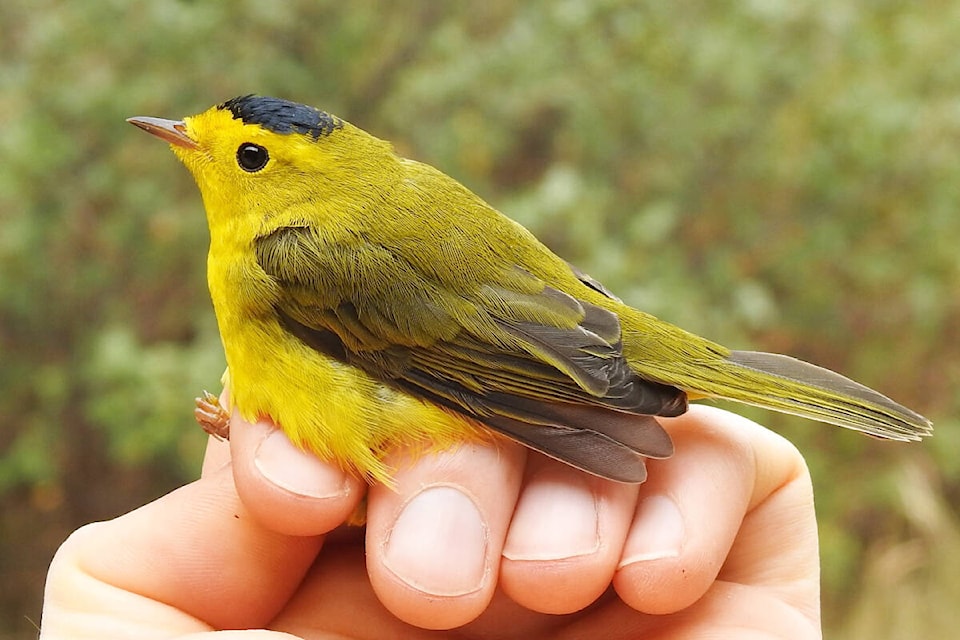For migratory birds, fall comes earlier than for most of us.
Once the year’s young have been raised, and (depending on the species of bird) they have moulted in a fresh set of feathers, songbirds, waterfowl, raptors, and others start their journeys southward to warmer destinations. For conservationists and bird researchers, this provides a perfect opportunity to monitor bird populations. Long term monitoring programs provide important information on the state of bird populations which is particularly important in the face of threats posed by climate change, forest fires, habitat loss etc.
The Tatlayoko Lake Bird Observatory is excited to announce the start of our 17th season of monitoring migrating birds in the West Chilcotin.
On August 3, two paid staff and our first volunteers will commence the fall program that includes daily bird counts via a one-hour morning census, observations made over a six-hour period and birds caught and banded over that same time frame.
This program runs until September 28. From early September to mid-October a three-hour Northern Saw-whet Owl banding program is run each night (weather permitting).
Last season (2022) was the lowest on record for the TLBO in terms of birds banded, with a total of just 945 compared to the average of over 1550.
We presume this was due to the cool and wet summer resulting in low success rates of raising young. With the extensive forest fires to the north of the Tatlayoko Valley this summer we hope that we don’t see a similar trend in the upcoming season.
In addition to the regular migration monitoring programs the TLBO often participates in other research projects.
In 2021 we joined a Motus project putting VHF tracking tags on nine Northern Saw-whet Owls and setting up a receiving station in the valley to detect tags from our own and other projects using this technology. Over the past year this receiving station has detected four birds with Motus tags: One of the owls tagged by us in 2021 was detected again in early September 2022 as it returned on its southward migration; two Swainson’s Thrushes tagged near Whistler in fall 2022 were detected in late May 2023 (see image of the “track” of detections of one of these).
Lastly, one Golden-crowned Sparrow tagged in the Lower Mainland in October 2022 spent the whole winter at that same site before making the ~350-400km flight in 9.5 hours on April 29, 2023, up to the Tatlayoko Valley where it was detected several times over a 13-hour period. Assuming this bird flew non-stop, this means it covered an average speed of between 37 and 42 kilometres per hour.
This fall the TLBO is aiming to increase our education program with field trips from at least four schools lined up for September. Through support from the Cariboo Regional District and the BC Gaming Grant we have been able to further develop our education program and buy several pairs of binoculars for use by the school kids and visitors alike.
Visitors are always welcome at the TLBO, just remember that our migration monitoring runs for six hours starting at sunrise (ending ~12:00 – 1:00pm).
To visit our owl banding program please contact us, at the email given below, ahead of time to ensure that we will be owling that night.
The TLBO is a program of the Tatlyoko Field Station Society and operates on property owned by Nature Conservacy of Canada.
The TLBO is funded by Canadian Wildlife Service, BC Gaming Grant, Otter Books, Avocet Tours, Jörg Fischer and Hannelore Ernst, Ruth and Charlie Travers, and a variety of other private donors. To find out more about how to donate to the TLBO, to arrange a visit to our owl banding or for any other questions please get in touch with us at tatlayokobirds@hotmail.com.
You can find more inforamtion about the TLBO as well as follow along with our banding season on our blog at www.tatlayokobirds.wordpress.com/.
READ MORE: Migration season arrives at the Tatlayoko Lake Bird Observatory
READ MORE: Bird population monitored at Tatlayoko Lake Bird Observatory
Do you have a comment about this story? email:
ruth.lloyd@wltribune.com
Like us on Facebook and follow us on Twitter.
